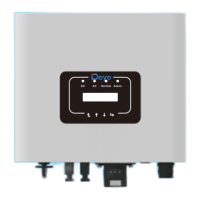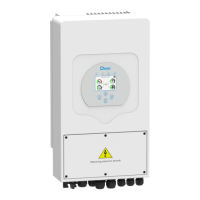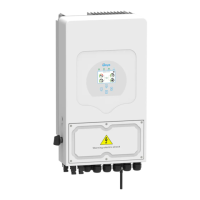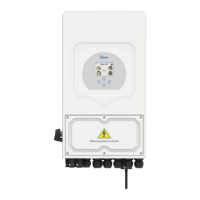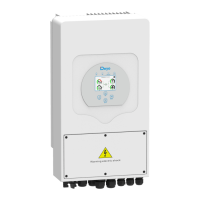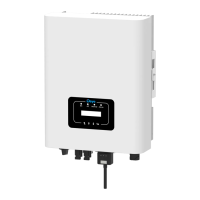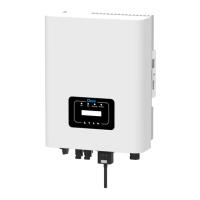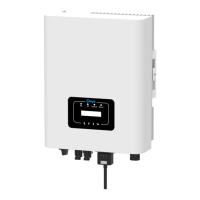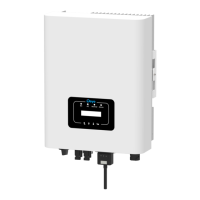Do you have a question about the Deye SUN-3.6K-G and is the answer not in the manual?
Describes the physical appearance of the single phase string power inverter models.
Lists all components included in the inverter package for user verification.
Explains safety symbols used in the manual to highlight potential risks and important information.
Provides critical safety guidelines for electrical installation and operation of the inverter.
Offers essential precautions and requirements for safe and proper operation of the inverter.
Details the front panel display and its components, including status indicators.
Explains the meaning of the four LED status indicator lights on the inverter's front panel.
Describes the function of the four keypad buttons on the inverter's front panel for navigation and control.
Outlines the information displayed on the inverter's two-line Liquid Crystal Display (LCD).
Provides criteria and recommendations for choosing a suitable and safe installation site for the inverter.
Details the procedure and requirements for physically mounting the inverter onto a wall or structure.
Guides the user through the process of connecting the DC input cables from the PV array to the inverter.
Explains how to connect the AC output cables from the inverter to the grid or load.
Describes the importance and procedure for connecting the ground wire for safety and performance.
Recommends the type and specification of circuit breakers for protecting the inverter from overcurrent.
Details how to connect the inverter for wireless remote monitoring using Wi-Fi or other methods.
Explains the steps for installing the datalogger module into the inverter.
Refers to external illustrations for the configuration process of the installed datalogger.
Provides a step-by-step guide for safely starting the inverter after installation.
Outlines the correct procedure for safely shutting down the inverter.
Explains how to set up and use the zero-export function using an energy meter.
Describes the optional sensor clamp for export limitation and its connection.
Details how to implement the zero-export function using a current transformer (CT) sensor.
Guides users on how to activate and configure the export limiter function on the inverter.
Offers important suggestions and precautions for using the zero-export and limiter functions safely.
Explains how to view PV plant load power and system status on a monitoring platform.
Describes the information displayed on the inverter's LCD upon initial startup and basic navigation.
Shows how to access and view device-specific information like model and software versions.
Explains how the inverter logs and displays fault records for troubleshooting.
Details the procedure for turning the inverter on or off via the interface.
Describes the optional setting for PV string current monitoring.
Introduces the main parameter categories available for system configuration and maintenance.
Covers settings for time, language, display, and factory reset options.
Details the adjustable running parameters for optimizing inverter performance.
Explains how to adjust the inverter's active and reactive power output.
Covers protective parameters, typically set by engineers for safety compliance.
Allows configuration of communication parameters like address and baud rate.
Provides guidance on cleaning the inverter to ensure optimal performance and readability.
Lists all possible error codes, their descriptions, and recommended solutions for troubleshooting.
Describes the physical appearance of the single phase string power inverter models.
Lists all components included in the inverter package for user verification.
Explains safety symbols used in the manual to highlight potential risks and important information.
Provides critical safety guidelines for electrical installation and operation of the inverter.
Offers essential precautions and requirements for safe and proper operation of the inverter.
Details the front panel display and its components, including status indicators.
Explains the meaning of the four LED status indicator lights on the inverter's front panel.
Describes the function of the four keypad buttons on the inverter's front panel for navigation and control.
Outlines the information displayed on the inverter's two-line Liquid Crystal Display (LCD).
Provides criteria and recommendations for choosing a suitable and safe installation site for the inverter.
Details the procedure and requirements for physically mounting the inverter onto a wall or structure.
Guides the user through the process of connecting the DC input cables from the PV array to the inverter.
Explains how to connect the AC output cables from the inverter to the grid or load.
Describes the importance and procedure for connecting the ground wire for safety and performance.
Recommends the type and specification of circuit breakers for protecting the inverter from overcurrent.
Details how to connect the inverter for wireless remote monitoring using Wi-Fi or other methods.
Explains the steps for installing the datalogger module into the inverter.
Refers to external illustrations for the configuration process of the installed datalogger.
Provides a step-by-step guide for safely starting the inverter after installation.
Outlines the correct procedure for safely shutting down the inverter.
Explains how to set up and use the zero-export function using an energy meter.
Describes the optional sensor clamp for export limitation and its connection.
Details how to implement the zero-export function using a current transformer (CT) sensor.
Guides users on how to activate and configure the export limiter function on the inverter.
Offers important suggestions and precautions for using the zero-export and limiter functions safely.
Explains how to view PV plant load power and system status on a monitoring platform.
Describes the information displayed on the inverter's LCD upon initial startup and basic navigation.
Shows how to access and view device-specific information like model and software versions.
Explains how the inverter logs and displays fault records for troubleshooting.
Details the procedure for turning the inverter on or off via the interface.
Describes the optional setting for PV string current monitoring.
Introduces the main parameter categories available for system configuration and maintenance.
Covers settings for time, language, display, and factory reset options.
Details the adjustable running parameters for optimizing inverter performance.
Explains how to adjust the inverter's active and reactive power output.
Covers protective parameters, typically set by engineers for safety compliance.
Allows configuration of communication parameters like address and baud rate.
Provides guidance on cleaning the inverter to ensure optimal performance and readability.
Lists all possible error codes, their descriptions, and recommended solutions for troubleshooting.
| Model | SUN-3.6K-G |
|---|---|
| Max. DC Input Voltage | 500V |
| Number of MPPT Trackers | 2 |
| AC Voltage Range | 180-280V |
| AC Output Frequency | 50/60Hz |
| THDI | <3% |
| DC Connection Type | MC4 |
| Protection Degree | IP65 |
| Rated Output Power | 3600W |
| Max. AC Output Power | 3600W |
| Rated AC Voltage | 230V |
| Power Factor | >0.99 |
| AC Connection Type | Plug |
| Operating Temperature Range | -25°C to +60°C |
| Cooling Method | Natural Cooling |
